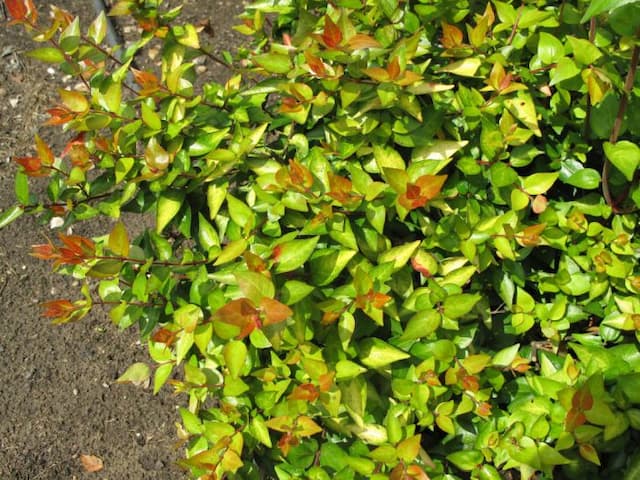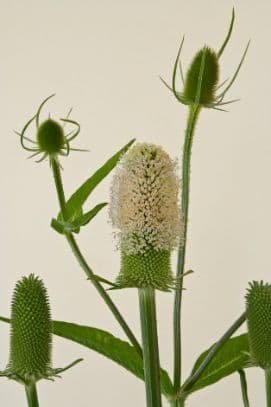Honeysuckle Lonicera periclymenum Chic et Choc = 'Inov205' (PBR)
ABOUT
Lonicera periclymenum Chic et Choc, commonly known as honeysuckle, boasts an alluring appearance marked by its twining and climbing habit which lends a romantic, cottage garden feel. The plant is adorned with striking flowers that exhibit a dual-tone palette; the outer part of the petals presents a creamy hue, while the inner whirl is graced with a delicate shade of pink, creating a captivating contrast. These blooms emit a sweet and potent fragrance, particularly as dusk settles, luring a symphony of pollinators such as bees and hummingbirds. Honeysuckle's foliage further enhances its aesthetic appeal, with leaves that are oval in shape, showcasing a deep green color, and arranged oppositely along the stems, providing a lush background that throws the vibrant flowers into sharp relief. As seasons transition from spring to late summer, the plant's blossoms give way to berries that add a burst of color and interest, which may attract an assortment of birds. The overall impression of Lonicera periclymenum Chic et Choc is one of enchanting beauty that can transform any garden landscape with its twining growth and floriferous display.
About this plant
 Names
NamesFamily
Caprifoliaceae
Synonyms
Honeysuckle Chic et Choc, Woodbine Chic et Choc
Common names
Lonicera periclymenum Chic et Choc = 'Inov205' (PBR).
 Toxicity
ToxicityTo humans
The plant Lonicera periclymenum, commonly known as honeysuckle, generally is not considered highly toxic to humans. However, some parts of the plant may contain glycosides which can be harmful if ingested in large quantities. The berries, particularly, are more likely to be toxic than the flowers or leaves. Symptoms of honeysuckle berry ingestion can include stomach upset, diarrhea, vomiting, and in more severe cases, it may lead to rapid heartbeat or respiratory difficulties. It's important to seek medical attention if significant quantities are consumed or if symptoms develop after ingesting any part of the honeysuckle plant.
To pets
Honeysuckle, or Lonicera periclymenum, can also be potentially toxic to pets. The berries are the most concerning part, as they can contain glycosides which might be poisonous if ingested in large amounts. If a pet eats honeysuckle berries, they may exhibit symptoms such as vomiting, diarrhea, and abdominal pain. Although the plant is not usually considered highly toxic, ingestion should still be avoided. In case a pet has consumed a considerable amount of the plant and is showing adverse reactions, it is important to consult a veterinarian.
 Characteristics
CharacteristicsLife cycle
Perennials
Foliage type
Deciduous
Color of leaves
Green
Flower color
Mixed
Height
6 feet (1.83 meters)
Spread
6 feet (1.83 meters)
Plant type
Climber
Hardiness zones
5
Native area
Europe
Benefits
 General Benefits
General Benefits- Attractive Flowers: Lonicera periclymenum Chic et Choc, commonly known as honeysuckle, produces beautifully colored and sweetly scented flowers that add aesthetic appeal to any garden.
- Wildlife Attraction: The honeysuckle's flowers are a nectar source for bees and hummingbirds, which can help pollinate other plants and contribute to biodiversity.
- Long Blooming Period: With a blooming period that extends from late spring through summer, this plant provides prolonged garden interest.
- Fragrance: The flowers emit a delightful fragrance, which can create a pleasant aromatic environment in the garden.
- Ease of Care: Honeysuckle tends to be low maintenance, needing only basic care to thrive.
- Garden Design Versatility: The climbing habit of honeysuckle allows it to be used for fences, trellises, or pergolas, offering multiple design options.
- Deciduous Foliage: The plant's foliage often turns a lovely yellow in autumn and drops for winter, making it a good choice for seasonal interest.
- Drought Tolerance: Once established, honeysuckle can tolerate periods of drought, making it suitable for gardens with less water availability.
- Fast Growth: Honeysuckle typically grows quickly, providing swift coverage or filling in spaces in a relatively short time.
 Medical Properties
Medical PropertiesThis plant is not used for medical purposes.
 Air-purifying Qualities
Air-purifying QualitiesThis plant is not specifically known for air purifying qualities.
 Other Uses
Other Uses- Attracting Beneficial Insects: Honeysuckle can serve as a habitat for beneficial insects, which help control pest populations in the garden.
- Support for Climbing Plants: The sturdy structure of Honeysuckle can act as a support for other climbing plants that may need assistance, like clematis or certain types of beans.
- Creating Garden Themes: With its vibrant colors and fragrance, Honeysuckle can be used to craft a sensory garden that focuses on stimulating the senses.
- Crafting Material: The flexible stems of Honeysuckle can be harvested and woven into decorative wreaths or used in other crafting projects.
- Teacher Aid: Educators can use Honeysuckle in lessons about pollination, plant biology, and ecology due to its attractiveness to pollinators and role in the ecosystem.
- Erosion Control: Planting Honeysuckle on slopes can help stabilize the soil and prevent erosion, due to its root system.
- Natural Playgrounds: Incorporating Honeysuckle in children's play areas can create natural tunnels or hideaways for imaginative play.
- Wildlife Photography: The vibrant flowers and visiting pollinators make Honeysuckle an excellent subject for wildlife and macro photography.
- Floral Arrangements: Fresh or dried Honeysuckle flowers can be used in bouquets or arrangements to add a splash of color and delicate fragrance.
- Privacy Screens: Honeysuckle can be grown as a dense hedge, providing privacy as well as aesthetic appeal with its flowers and scent.
Interesting Facts
 Feng Shui
Feng ShuiThe Honeysuckle is not used in Feng Shui practice.
 Zodiac Sign Compitability
Zodiac Sign CompitabilityThe Honeysuckle is not used in astrology practice.
 Plant Symbolism
Plant Symbolism- Love: Lonicera periclymenum, commonly known as Honeysuckle, is often seen as a symbol of love and devotion due to its ability to tightly twine around structures, reminiscent of an embrace.
- Bonds of Affection: The entwining nature of Honeysuckle vines also represents strong bonds of affection and the enduring nature of relationships.
- Sweetness: The sweet-smelling flowers of the Honeysuckle are indicative of the sweetness of life and the joy of new experiences.
- Happiness: The fragrant and brightly colored flowers are often associated with the cheerfulness and happiness in life.
- Generosity: The abundant nectar of Honeysuckle flowers signifies generosity and the willingness to give to others.
 Water
WaterThe Honeysuckle 'Chic et Choc' should be watered thoroughly, ensuring the soil is moist but not waterlogged. During the growing season, typically spring through summer, water the plant once a week with about 1 to 1.5 gallons, depending on the weather conditions and soil drainage. In the winter months, reduce watering frequency to every two weeks or less, using only 0.5 to 1 gallon, as the plant's growth slows down and requires less moisture. Always check the soil moisture before watering; if the top inch is dry, it is time to water. Ensure that the plant has adequate drainage to prevent root rot.
 Light
LightHoneysuckle 'Chic et Choc' thrives in full sun to partial shade. It performs best when it receives at least 6 hours of direct sunlight per day, but it can also tolerate dappled sunlight, especially in hot climates. The ideal spot for the plant would be in an area that gets morning sun and afternoon shade, which helps protect it from the intense heat of the day.
 Temperature
TemperatureHoneysuckle 'Chic et Choc' prefers a temperate climate and can withstand a range of temperatures. The plant is hardy in USDA zones 4 through 9, which means it can tolerate minimum temperatures down to -20 to -30°F and can handle summer temperatures well above 80°F. The ideal temperature range for optimal growth is between 60°F and 75°F.
 Pruning
PruningPruning Honeysuckle 'Chic et Choc' is important to maintain its shape, encourage airflow, and promote vigorous blooms. Prune in late winter or early spring before new growth begins, removing any dead or damaged branches and about one-third of the oldest stems to stimulate new growth. Additionally, light pruning after the first flush of flowers can encourage a second bloom. The best time for pruning is after the plant has flowered, to shape the plant and control its size.
 Cleaning
CleaningAs needed
 Soil
SoilThe best soil mix for Honeysuckle 'Chic et Choc' should be well-draining, fertile, and retain moisture without becoming waterlogged. Loam-based compost mixed with organic matter like peat or leaf mold is ideal. Aim for a soil pH between 5.5 and 7.
 Repotting
RepottingHoneysuckle 'Chic et Choc' should be repotted every 2 to 3 years or when the plant has outgrown its current container. Spring is the best time for repotting to allow the plant to establish in the new pot before the growing season.
 Humidity & Misting
Humidity & MistingHoneysuckle 'Chic et Choc' prefers moderate humidity levels, typically between 40-60%. It can adapt to the average outdoor humidity levels but avoid placing it in excessively dry or arid environments.
 Suitable locations
Suitable locationsIndoor
Ensure bright indirect light and regular pruning for indoor Honeysuckle 'Chic et Choc'.
Outdoor
Plant in sun to partial shade, shelter from harsh winds for outdoor Honeysuckle 'Chic et Choc'.
Hardiness zone
4-9 USDA
 Life cycle
Life cycleCommonly known as Honeysuckle 'Chic et Choc', Lonicera periclymenum 'Inov205' begins its life as a seed or may be propagated via cuttings. The seeds germinate in the spring, developing into seedlings with their first true leaves. As the plant matures, it enters a vegetative stage, during which it grows vigorously, producing shoots and leaves capable of photosynthesis. This cultivar is a deciduous climber and will experience a period of dormancy in winter, where growth slows and leaves may be shed. In late spring to summer, 'Chic et Choc' transitions into the reproductive stage, blossoming with fragrant flowers that attract pollinators, setting the stage for pollination and subsequent fruit formation. Finally, after seed dispersal in autumn, the plant will re-enter dormancy, awaiting the next growth cycle in spring.
 Propogation
PropogationPropogation time
Spring-Early Summer
Lonicera periclymenum Chic et Choc, commonly known as Honeysuckle 'Chic et Choc', is most popularly propagated through semi-hardwood cuttings. The best time to take these cuttings is during late summer to early fall. To propagate, choose a healthy, non-flowering stem and cut a 4 to 6 inch (10 to 15 cm) section just below a leaf node. Remove leaves from the lower half of the cutting and dip the cut end in rooting hormone powder to encourage root growth. Plant the cutting in a well-draining potting mix, water it well, and cover with a plastic bag or a propagator to maintain humidity. Keep the cutting in a warm place with indirect sunlight until roots develop, which typically takes several weeks. Once rooted, the cutting can be transplanted to a larger pot or into the garden.








